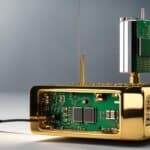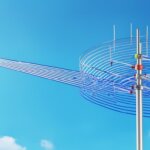Table of Contents
RFID (radio frequency identification) is a form of wireless communication that uses electromagnetic or electrostatic coupling in the radio frequency spectrum to uniquely identify objects, animals, or people. It consists of three components: a scanning antenna, a transceiver, and a transponder. The scanning antenna and transceiver together form an RFID reader, which uses radio waves to activate the tag and receive data from it.
RFID tags can be active or passive, and they typically contain an integrated circuit, an antenna, and a substrate. They can be read-only or read-write and have different read ranges depending on factors such as the type of tag and reader. There are three main types of RFID systems based on frequency: low frequency (LF), high frequency (HF), and ultra-high frequency (UHF).
RFID tags have a wide range of applications across industries, including supply chain management, inventory tracking, access control, and asset management. The technology offers various functions, benefits, and applications that make it an essential tool in modern tracking and identification systems.
Next, we will delve deeper into how RFID technology works and explore its different components and functionalities.
How Does RFID Work?
In an RFID system, the scanning antenna of the RFID reader sends radio waves to activate the RFID tag, which contains a transponder. The tag responds by sending a wave back to the antenna, where it is translated into data. The data can be unique identifiers or other information encoded in the tag’s memory. The read range of RFID tags varies based on factors such as the type of tag, type of reader, RFID frequency, and environmental interference.
Active RFID tags have a longer read range than passive RFID tags because they have their own power source. RFID tags can be used for various applications, including supply chain management, asset tracking, access control, and inventory management.
How RFID Works in Detail
- The scanning antenna of the RFID reader sends radio waves to activate the RFID tag.
- The activated RFID tag, which contains a transponder, responds by sending a wave back to the antenna.
- The antenna receives the wave sent by the tag and translates it into data.
- The data can be unique identifiers or other information encoded in the tag’s memory.
RFID tags play a crucial role in capturing data and enabling seamless communication between objects or items in various industries.
The read range of RFID tags is influenced by several factors, including the type of tag and reader, RFID frequency, and environmental interference. Active RFID tags, which have their own power source, can transmit signals over a longer distance compared to passive RFID tags, which rely on power supplied by the RFID reader.
RFID technology provides valuable benefits across numerous sectors, from supply chain management to asset tracking, access control, and inventory management. Its ability to accurately capture and transmit data in real-time makes it a reliable solution for businesses seeking to optimize their operations.
RFID tags have revolutionized industries by enhancing efficiency, accuracy, and traceability. With their wide-ranging applications, RFID systems continue to drive innovation and improve business processes.
Types of RFID Systems
RFID systems are categorized based on their frequency, with three main types: low frequency (LF), high frequency (HF), and ultra-high frequency (UHF). Each type has its own characteristics and applications.
Low Frequency (LF) RFID Systems
Low-frequency RFID systems operate between 30 KHz and 500 KHz, with a typical frequency of 125 KHz. These systems have a short transmission range, usually ranging from a few inches to less than six feet. LF RFID systems are commonly used for applications such as access control and animal tracking.
High Frequency (HF) RFID Systems
High-frequency RFID systems operate between 3 MHz and 30 MHz, with a typical frequency of 13.56 MHz. They have a longer range compared to LF systems, ranging from a few inches to several feet. HF RFID systems are used in various applications including contactless payment, inventory management, and document tracking.
Ultra-High Frequency (UHF) RFID Systems
Ultra-high frequency (UHF) RFID systems operate between 300 MHz and 960 MHz, with a typical frequency of 433 MHz. These systems have an extended read range and can be read from distances of 25-plus feet away. UHF RFID systems are commonly used in asset tracking, supply chain management, and inventory management applications.
Microwave RFID Systems
Microwave RFID systems operate at 2.45 GHz and have the longest read range, reaching distances of 30-plus feet. These systems are ideal for applications that require long-range reading, such as toll collection and vehicle identification.
The frequency range used in RFID systems depends on the specific application requirements, and the actual read ranges may vary based on factors such as tag type, reader power, and environmental interference. RFID technology finds applications in various industries for tasks such as access control, inventory tracking, and supply chain management.
RFID Applications and Use Cases
RFID technology has been widely adopted across various industries due to its numerous benefits and applications. In recent years, the decreasing costs of RFID tags and readers have led to increased adoption in commercial settings. The common uses of RFID span a wide range of sectors, including supply chain management, asset tracking, logistics, industrial and manufacturing applications, brand protection, anti-counterfeiting, access control, healthcare, retail, and entertainment.
One of the key advantages of RFID over traditional barcodes is its ability to identify objects without requiring direct line of sight. With RFID, objects can be quickly and accurately identified and tracked, even in busy or cluttered environments. RFID tags also offer longer read ranges compared to barcodes, enabling more efficient and convenient data collection.
Another advantage of RFID is its ability to provide real-time data updates. This allows businesses to have accurate and up-to-date information about their inventory, assets, or products, improving operational efficiency and decision-making. Furthermore, RFID tags have the capacity to store more information than barcodes, making it possible to include additional data such as product specifications or maintenance history.
In addition to its applications in traditional RFID systems, near-field communication (NFC) is a subset of high-frequency (HF) RFID technology that enables secure wireless communication between devices. NFC is commonly used for contactless payments and other applications where secure communication is essential.
In summary, RFID technology continues to evolve and find new applications in various industries. Its adoption has been driven by cost reductions and the ability to overcome the limitations of traditional barcodes. With its wide range of uses, RFID is revolutionizing supply chain management, asset tracking, access control, and many other areas, providing businesses with improved efficiency, accuracy, and overall operational performance.
FAQ
What is RFID tag technology?
RFID (radio frequency identification) is a wireless communication technology that uses electromagnetic or electrostatic coupling to identify objects, animals, or people. RFID tags consist of an integrated circuit, an antenna, and a substrate, and they can be read-only or read-write.
How does RFID work?
In an RFID system, the scanning antenna of the RFID reader sends radio waves to activate the RFID tag. The tag responds by sending a wave back to the antenna, which is then translated into data. This data can be unique identifiers or other information encoded in the tag’s memory.
What are the different types of RFID systems?
RFID systems can be categorized into low frequency (LF), high frequency (HF), ultra-high frequency (UHF), and microwave based on their frequency ranges. The read ranges of these systems vary depending on the type of tag, reader, and environmental factors.
What are the applications and use cases of RFID?
RFID technology has a wide range of applications across industries, including supply chain management, inventory tracking, access control, and asset management. It has advantages over barcodes, such as longer read ranges, real-time data updates, and the ability to identify objects without direct line of sight.







